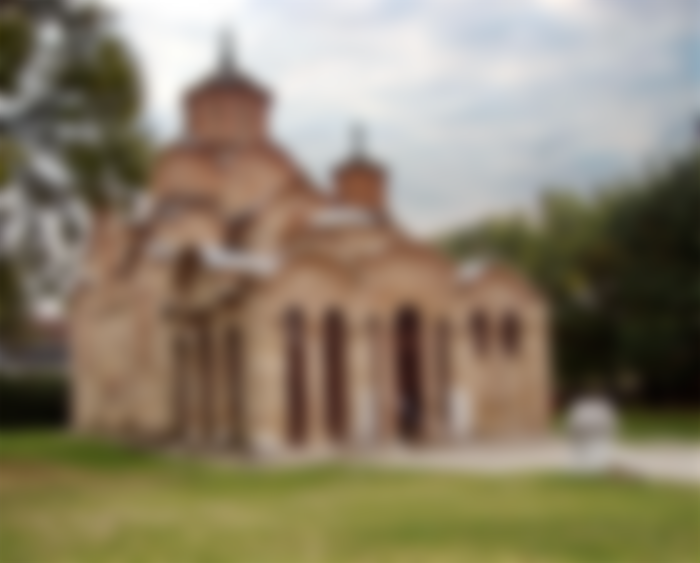
The Nemanjićs are the most famous medieval Serbian dynasty that ruled this area for more than two centuries. It was named after its founder, Stefan Nemanja, who was the great prefect of Raska and the ruler who laid the foundations for the creation of a powerful Serbian state in the Middle Ages. The dynasty gave eleven rulers, the last of whom was Tsar Stefan Uroš V, also known as Nejaki. They ruled Serbia from 1166 to 1371.
The first who, consciously or unconsciously, started this tradition was actually Stefan Nemanja
His personal name was Nemanja and as such it is mentioned in many written sources of that time. The name Stefan in the sense as it was used by the founder of the dynasty, and later by all his descendants, is actually a kind of title and in a figurative sense means king / ruler.
Stefan is a male name of Greek origin. It comes from the word "Stephanos" which means "wreath, crown". Stefan is actually "the one who was crowned". This name was carried by many European kings - English, Hungarian and Polish, and after Stefan Nemanja and all his descendants, heirs to the Serbian throne.
All of them, in addition to the ruler's name Stefan, also had a personal name - Stefan Prvovencani (his full name was actually Stefan Nemanja II), Stefan Radoslav, Stefan Vladislav, Stefan Uros I, Stefan Dragutin, Stefan Uros II Milutin, Stefan Vladislav II, Stefan Uroš III Dečanski, Stefan Uroš IV Dušan, and Stefan Uroš V. The name Stefan was added to the honor of the founders of the dynasty, tradition, but also a symbolic confirmation of their right to rule.
The Nemanjic dynasty left many endowments. I have already written about them in the article https://read.cash/@ruza17/in-the-footsteps-of-our-ancestors-some-of-the-endowments-of-the-first-serbian-ruling-dynasty-8d392fbc, and now I will introduce you to some more of them.
Mileseva

Near Prijepolje is the Mileseva Monastery, the endowment of King Vladislav.
In the narthex, which was added by King Vladislav in 1235, he laid the relics of his uncle Saint Sava. During the conquest in 1594, the Turks transferred them to Vračar (Belgrade) and burned them, in an attempt to break the Serbian spirit.
The monastery was founded during the Latin Empire, when the so-called "plastic style" was created, which is characterized by monumentality, avoids decorativeness and leans towards forms of classical antiquity. In 1377, Tvrtko I Kotromanić was crowned King of the Serbs and the Littoral in the monastery church. In 1446, Stefan Vukčić Kosača proclaimed himself "Duke of Saint Sava", after which Herzegovina was named.
The Milesevska printing house was here in the 16th century.

Mileseva's frescoes are among the best European achievements of the 13th century, and the most famous of them is the White Angel, which is part of the Myrrh-bearing fresco on Christ's tomb. In addition to the White Angel, other masterpieces are the Mother of God from the Annunciation and the Founder's Composition with a portrait of King Vladislav. These works also represent the greatest achievements of painting of that time in Europe.
Historical portraits: Iconography of Nemanjić, prince Vladislav on the south wall, and figures of Nemanja, Saint Sava, Stefan the First-Crowned, Radoslav and Vladislav on the northeast.
Pec Patriarchate

In 1219, Saint Sava established the first autocephalous archbishopric in the Serbian lands. It was the medieval Serbian archbishopric, which in history is called Zickom, or Peckom or Zicko-Peckom archbishopric. Tsar Stefan Dušan expanded its borders and raised its reputation by elevating it to the rank of patriarchy in 1346. Then, the Serbian archbishop Joanikije II was proclaimed the first Serbian patriarch with the throne in Pec.
The unfortunate political nature of the Serbian church after the fall of Smederevo (1459) came under the rule of the Ohrid Archbishopric. Only after a hundred years, the Sokolović brothers, Mehmed-paša Sokolović and Makarije Sokolović, managed to restore the independent Patriarchate of Pec
.The renewed Patriarchate of Pec is the most deserving for the Serbian national unification. Instead of the ruler, who, even when she was the best, still primarily looked after personal interests, the clergy was a more reliable leader. It was more difficult for the Patriarchate of Peja to protect the Serbian ranks from Islamization by culting the people's past and preaching national and religious solidarity, than to follow the heated religious struggle in the West.
Sopoćani

The monastery of Sopoćani, the home of the Holy Trinity, was built by King Stefan Uroš I (1243—1276) not far from the source of the river Raška.
The monastery is located 17 km west of Novi Pazar. At this place, the source of the Serbian medieval state of Nemanjić, the third son of King Stefan the First-Crowned left behind an endowment that surpasses all previous Serbian churches in its size and beauty. The frescoes of the Sopoćani monastery are a true masterpiece of art, which brought world fame to the people of Sopoćani many years later. Today, it is one of the most important Serbian cultural monuments, which in 1979 was included on the UNESCO World Heritage List as part of the monuments of the Middle Ages united under the protected whole of Stari Ras and Sopoćani.
Today, it is difficult to specify when Sopoćani was built. The most probable assumption is that the monastery was built in the second half of the reign of King Stefan Uroš I, most probably around 1260. This conclusion was reached by a detour, considering that the conclusion that the frescoes of the monastery were made in the 1960s is quite reliable. During the period of Ottoman rule, in the 17th century, the monastery suffered significantly, and was rebuilt in the first decades of the 20th century.
Gračanica

The Gračanica Monastery was built by King Milutin in 1321 and dedicated to the Assumption of the Most Holy Mother of God. The monastery is located in the village of Gracanica, 10 km away from Pristina, the administrative center of Kosovo and Metohija.
The church has frescoes depicting the genealogy of the Nemanjić dynasty, a copy from the Decani monastery, then the figure of Queen Simonida, the wife of King Milutin and the daughter of the Byzantine emperor Andronikos II.
In the 16th century, the narthex was painted with frescoes. Mihajlo and Evtihije, famous painters from Thessaloniki, finished the frescoes in the main church by 1321. Heavenly liturgy, prophets and evangelists are painted on the main dome under the fresco of Christ Pantocrator, while on the walls of the nave you can see cycles of the Great Feasts, Christ's suffering, miracles, stories, Christ's Nativity and Resurrection, scenes from the life of the Virgin, St. Nicholas and the Calendar of Saints. Scenes depicting the Eucharist as well as Old Testament motifs are found in the altar. Sv. King Milutin and his wife Queen Simonida, a Byzantine princess, are depicted in the central arch as rulers to whom God grant power through angels who place crowns on their heads. The Nemanjic tree of origin and the Last Judgment are painted in the front part of the nave, while fragments of frescoes from the 14th century have been preserved outside the narthex. Among other frescoes, the cycles of the Ecumenical Councils, the Akathist of the Most Holy Mother of God and the Birth of the Lord are significant.
Visoki Dečani

Visoki Dečani Monastery is a Serbian medieval Orthodox monastery - the endowment of King Stefan of Dečani and Tsar Dušan. The initiative for the construction of this monastery belonged to Saint Sava. King Uroš III of Decani clearly stated in his chrysostom that the place for the erection of the temple of God in Decani was chosen by Saint Sava I Nemanjić, but death overtook him, and King Uroš III was destined to build a monastery there. [1] Construction lasted between 1326/1327. and 1334/1335. year, the frescoes were completed around 1348. The monastery is dedicated to the Ascension of the Lord - Savior's Day (the fresco of the holiday is also shown in the dome called Christ the Almighty, omnipotent - in Greek Pantocrator). The main builder was master Vito Kotoranin.
I hope you enjoyed this walk in which we visited the medieval monasteries built by the Nemanjic dynasty.







Good one